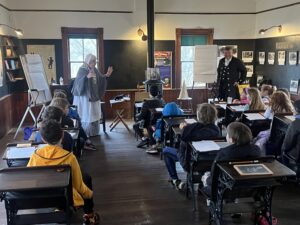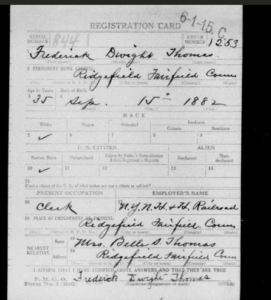The Revolutionary War in Ridgefield: A History of Continuing Revelations
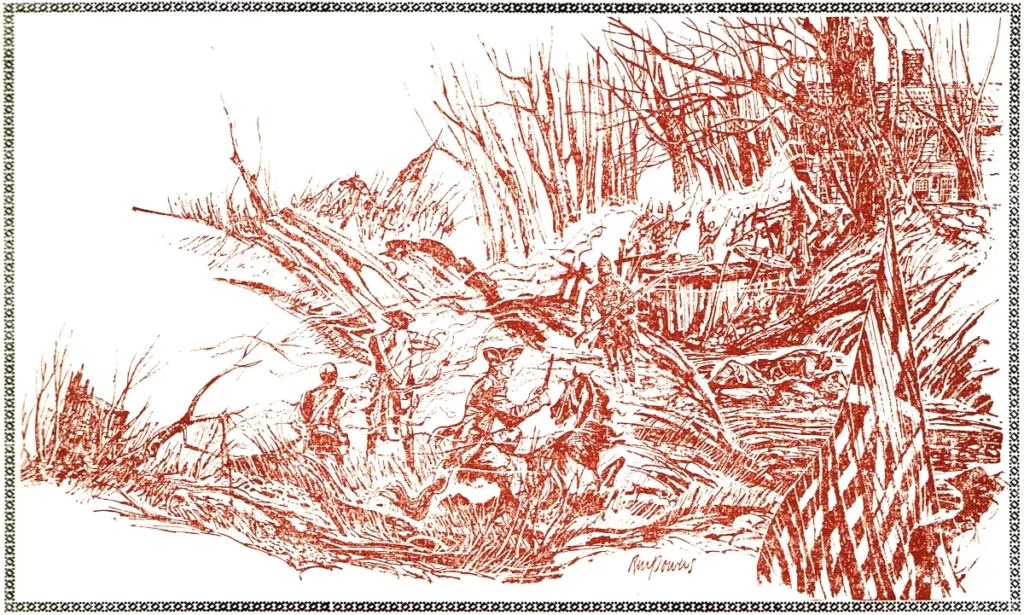
The history of the Battle of Ridgefield is a tale that is always unfolding, often in surprising ways. Sometimes, discoveries are the result of deliberate research; sometimes, it’s merely by chance that something new is revealed.
It’s a familiar story now, how a construction project in late 2019 brought workers face to face with the remains of what are believed to be soldiers from the Revolutionary War. Two and a half years later, a major study of the battle is nearing completion and the analysis of the recovered skeletons continues, with hopes that eventually there will be a clearer picture of who these young men were.
The Ridgefield Historical Society had representatives at the site of the skeletons’ retrieval in 2019 and provided context to the archaeologists who did the work. In response to the great interest aroused by the discovery, the Historical Society launched an effort to generate further study of the Battle. The result was a National Park Service American Battlefield Protection Program grant.
While early work was hampered by the closures of research libraries and offices due to the pandemic, the past two years of work by paid consultants and volunteers has yielded extensive documentation of the Battle of Ridgefield and guideposts for future investigation.
Their final “Technical Report” is now a part of the Ridgefield Historical Society’s permanent collection, available to read online.
While the report was directed toward identifying primary sources and documenting the extent of the battle site (and showed that the battle was more of a running engagement than previously thought), it was only the first step in expanding battlefield scholarship. In its request for a second National Park Service grant, the Ridgefield Historical Society, working again with the Connecticut State Historic Preservation Office, explained that goals include more targeted research into the battle as well as doing more archaeological studies, which will entail community and property-owner outreach.
As part of the Phase I grant now being completed, the Ridgefield Historical Society has engaged FHI Studio of Hartford to lead two planning charrettes (May 12, virtually; June 12, in person) at which townspeople will be able to share their thoughts on how Ridgefield should understand and protect its unique Revolutionary War heritage.
The goals of the Phase II project are:
- to continue targeted historical research;
- expand and elaborate on understanding of the battle and the individual participants within units, including soldiers from underrepresented racial and ethnic groups who participated in the battle;
- define battlefield boundaries through archeological means;
- identify and record areas of integrity;
- heighten community and individual investment and engagement in the project;
- and assess the eligibility of the battlefield for nomination to the National Register of Historic Places.
In 2026, the American Semiquincentennial will bring added interest to the places associated with the country’s fight for freedom. Ridgefield, as the site of the only inland battle in Connecticut during the Revolution, as well as the site of a heroic stand by General Benedict Arnold, will have a prominent role to play.
Looking ahead: The human toll of war
The discovery of Revolutionary War-era skeletons brought home the real costs of the Battle of Ridgefield. As State Archaeologist Nick Bellantoni carefully freed the bones from the dirt, their positioning (lying close together, feet to the East, but somewhat haphazardly) told a story, yet to be confirmed, of a hasty burial. Contemporary records and later pension applications help fill in gaps in knowledge of the fate of soldiers from the battle; requests for compensation by Ridgefield property owners tell their stories to some extent.
One of the areas that will draw more research in coming years will be the fate of Ridgefielders who chose loyalty to the Crown over the rising rebellion. Ridgefield did not move easily to the Revolution (twice, townspeople voted to remain loyal to the King, before switching to the Patriot side) and more than one family was divided by its members’ choices.
As more early documents are scanned and shared digitally by the State Library and other sources, new avenues for research open up.
Recent work by Ridgefield historian Jack Sanders followed a tantalizing clue about a woman who testified against eight Ridgefielders who’d gone over to the Loyalist side and escaped to Long Island. Her name was Mary Ann Portman; she signed a document with “her mark” for a Fairfield County Court deposition on Nov. 10, 1779, before Ridgefield Justice of the Peace John Benedict. Portman testified
that I being on Long Island last May, I there saw Jeremiah Smith, late of Ridgefield, also Benjamin Burt, Joshua Burt and David Burt, Jonah Smith, James Morehouse & Daniel Sherwood, all late of said Ridgefield, who all appeared well pleased with their situation, except Joshua Burt who manifested a desire to return home, but thro fear of the consequences, he durst not run the venture, and also that I saw Benjamin Stebbins the 3d, late of said Ridgefield, who was an enlisted soldier in the service of the enemy.
Two years earlier, she had reported Jabez Prindle of Newtown as a loyalist on Long Island, according to records in the Connecticut State Library.
While her death is recorded in Ridgefield on April 5, 1806, when she was described as “Widow Mary Ann Portman” (and she was included in the 1790 census as a single, white female head of household), more information about her is not easily found. Was she a spy? A double agent? Did she travel between Ridgefield and Long Island often? Was there some personal animus that caused her to testify against those men?
Records of the Loyalists she reported are another avenue of research that will add to a fuller picture of Ridgefield’s involvement in the Revolutionary War. The full story of Ridgefield’s Revolutionary War history is indeed a work in progress; tantalizing clues abound.
Answering Their Town’s Call: Fire Department Marks 125 Years
As Ridgefield returns to traditional community celebrations, like the Battle of Ridgefield re-enactment and the Memorial Day Parade, the town has a special event to look forward to in June: Celebrating the 125th anniversary of the formation of the Ridgefield Fire Department.
The Firemen’s Carnival, long a highlight for youngsters at the end of the school year, will take place from June 22 to 25 at East Ridge Middle School. The big events will be the 125th Anniversary Parade, with up to 50 fire departments and many marching bands, on Friday, June 24, starting at about 6:30 and fireworks on Saturday, June 25, around 9 p.m. (Details will be posted at the inRidgefield website.)
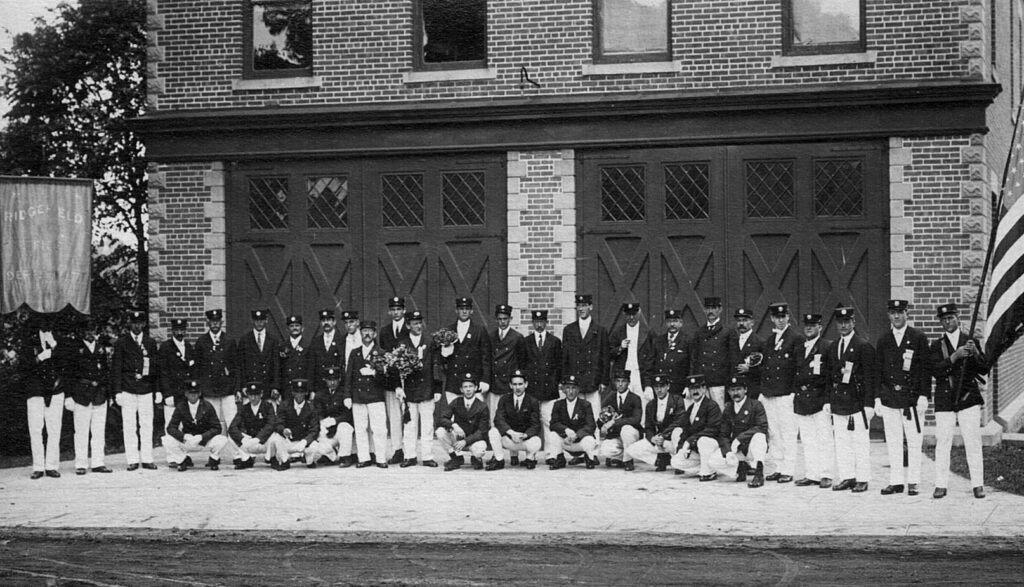
Ridgefielders have fought fires throughout the town’s more than 300 years, but until close to the turn of the 20th Century, the methods were limited by lack of water and equipment — and organization.
What brought the town to the adoption of modern firefighting techniques? A historic blaze that nearly destroyed all of the center of town.
Fifty years ago, in 1972, Elizabeth Leonard wrote a history of the fire department in honor of its diamond anniversary. (She was the former Ridgefield reporter for the Danbury News-Times and would become the state representative from Ridgefield in 1976 and the town’s first woman first selectman in 1981.)
Her history began:
At about 9 p.m. on Sunday, December 8, 1895, an event began, which, within the next few hours, would destroy most of the business area on the east side of Main St. The event also led to the birth of the Ridgefield Fire Department.
The Great Fire of 1895 spread in three directions from the origin in the Gage Building (now D. F. Bedient’s) at the corner of Bailey Avenue and Main St. It destroyed two adjacent buildings to the north, another building to the east along Bailey Avenue, and then headed south toward Governor St.
Town Hall was in flames. The church bells had sounded the fire alarm and hundreds of residents had responded but they could do little because there was no fire-fighting apparatus.
Bucket brigades were useless. Dynamite was tried on the Masonic Hall but the building was already on fire and the blaze could not be stopped there. Workers raced ahead of the fire and tore down a portion of the Scott building. With nothing left to feed upon, the conflagration was finally checked—but not before it reduced to ashes and rubble 10 buildings which housed 13 businesses and caused over $100,000 in destruction.
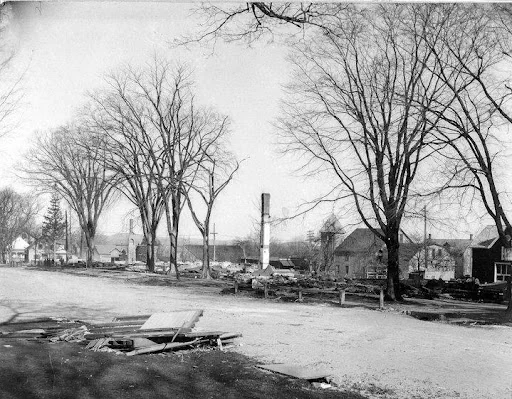
Within months, a fire district was formed and former Governor Phineas C. Lounsbury had donated two pieces of apparatus: a chemical engine truck and a hook and ladder truck with a pump. (Both could be drawn by men or teams of horses.) A special town meeting in early 1897 approved making space in the new Town Hall to house the fire-fighting equipment.
The hand-written record of the formation of the Ridgefield Fire Department reported on Feb. 10, 1897 that Charles S. Nash was elected chief at an organizational meeting, with two fire companies headed by foremen, James W. Fogarty for the Phineas C. Lounsbury Engine Company and George Abbott for the Caudatowa Hook and Ladder Company. More than 70 men were charter members of the new department.
It was clear that a water supply system was needed. The late Town Historian Richard E. Venus, in his Ridgefield Press column, “Dick’s Dispatch,” wrote in the 1980s about the Great Fire and the subsequent creation of a village water supply:
The many wooden buildings were like tinder to the fierce flames and the need for a water system was quite apparent. Shortly thereafter, a water system was devised by piping water from a series of springs on West Mountain. After only a few years, it was recognized that the system was not adequate for a citizenry that had become very conscious of the devastation a fire could cause.
Henry B. Anderson, a very enterprising man, turned his attention to the problem and decided to buy the toddling Ridgefield Water Supply. Under his careful guidance, lines were laid from Round Pond to a standpipe at the rear of the William Harrison Bradley estate on West Mountain. From this vantage point, water flowed by gravity to an artery of pipes and to the fire hydrants in the Village District. Many of these pipes are still in use today, eighty-one years after their installation.
The Ridgefield Historical Society protects the early records of the fire department in the Scott House’s climate-controlled vault, along with many other documents and photographs that detail Ridgefield’s rich history, including some of its memorable fires.
One large collection of photographs captures a spectacular blaze that recalled the Great Fire of 1895, but with very different results. It was 2005 when flames from one of the buildings rebuilt in 1896 threatened Main Street — the iconic Bissell building caught fire in the middle of the night in late May. This time, a modern firefighting force was on the scene in minutes. Although that building eventually burned to the ground, departments from throughout the region responded to aid Ridgefield career and volunteer firemen and were able to confine the fire, protecting buildings that were separated from the blaze only by alleyways. It’s a bit of modern history that’s still fresh in the memories of many Ridgefielders.
As the Ridgefield Fire Department celebrates its 125th anniversary, the town of Ridgefield celebrates the dedication and decades of service by all the volunteers and career firefighters. See you at the parade!
President’s Message
As we share our April 2022 Scott House Journal, the 245th Anniversary of the Battle of Ridgefield approaches. It is going to be a spectacular weekend for our town. From my perspective, it already is.
As a first-time member of the Battle of Ridgefield (BOR) Anniversary organizing committee, I am already awed by the event and the extraordinary enthusiasm and generosity of those putting it together. It is truly a labor of love, fueled by hard work, creativity, and genuine passion. Some of those volunteering to the effort are BOR veterans. Others are brand new to the occasion, but all are offering all they can — for the enlightenment and entertainment of others, and to highlight the special history we cherish and share.
How lucky are we?
I think I can speak for the entire Ridgefield Historical Society: It is very gratifying to have history front and center, and to have the perfect platform from which to share our new findings about the Battle of Ridgefield, learned through the National Park Service American Battlefield Protection Program grant, awarded to the Historical Society in 2020. The spirit of community and collegiality present in this event is inspiring. In this Battle of Ridgefield, we are all on the same side and we’re working together to create this most spectacular of events.
The Battle of Ridgefield Anniversary commemoration is a large undertaking with many moving pieces and I’d like to thank several individuals and organizations for their participation and contributions. To our First Selectman Rudy Marconi, the dedicated Board of Directors and staff at the Ridgefield Historical Society, the Ridgefield High School Orchestra, our amazing panelists, the reenactors, and all of the talented volunteers who have put in countless hours, and to our generous sponsors, we could not have pulled this off without you!
I hope you can all enjoy some or all of the 245th Anniversary of the Battle of Ridgefield from Friday, April 29 through Sunday, May 1. It’s going to be quite transporting.
Cross your fingers for good weather!
TRACY SEEM,
President, Ridgefield Historical Society




